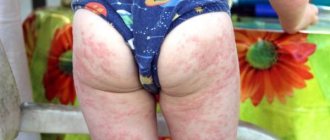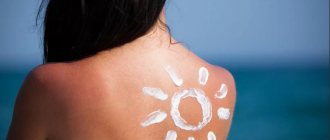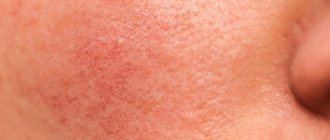Last update: 02/21/2021
Photodermatitis or sun allergy is a specific reaction of the skin to ultraviolet rays falling on it. This sensitivity most often occurs in people with very fair skin, belonging to the so-called Scandinavian type of appearance, but it also occurs in other cases. Symptoms and treatment for dermatitis may vary in each individual case of the disease.
Sun allergy: what is it?
There is no need to think that the allergen that causes inflammation is the sun's rays themselves. The mechanism of the disease is somewhat more complicated. Increased susceptibility to ultraviolet radiation is caused by the presence in the patient’s body of sun-sensitive substances - photosensitizers. The interaction of their radicals with skin protein leads to inflammation.
In addition, not only solar dermatitis occurs, but also a violent reaction of the body to artificial tanning. By the way, frequent visits to the solarium can provoke an allergy to the sun's rays.
Photodermatitis and its prevention
Allergist, Head of the Department of Allergology and Occupational Pathology Dudareva N.I.
Photodermatitis is a type of dermatitis caused by increased sensitivity to ultraviolet (sun) rays; it manifests itself as a polymorphic rash on the skin. It can be either an independent disease or a symptom of a disease (for example, systemic lupus erythematosus).
According to various sources, every fifth person has encountered manifestations of photodermatitis at least once in their life. The highest incidence of photodermatitis is observed in people with fair skin, children and pregnant women. There is also a genetic predisposition to photodermatitis and most often it is transmitted through the female line. With pathologies such as porphyria, hemosiderosis, photodermatitis as a symptom manifests itself in 90 - 95 percent of cases.
Photodermatitis can also be an occupational pathology. Thus, fishermen, sailors, and people working outdoors develop chronic solar dermatitis (dermatitis solaris). In representatives of these professions, photodermatitis manifests itself not so much as rashes, but rather as pigmentation (darkening) and constant peeling.
Conditions that cause increased sensitivity to sunlight:
- with insufficient amount of melanin in the skin;
- in the presence of substances in the skin that cause phototoxicity;
- for vitamin deficiencies and other conditions accompanied by reduced immunity.
The most common substances that are phototoxic:
1. Essential oils – bergamot, sandalwood, rose oils. They are contained in creams, perfumes, deodorants;
2. Furocoumarins are substances that are secreted by some meadow plants and which subsequently settle on human skin (“meadow photodermatitis”);
3. Medicines – accumulate in the skin when used orally:
- o antibacterial drugs – tetracycline, doxycycline, biseptol;
- o neuroleptics and antidepressants – chlorpromazine, doxepin;
- o antiarrhythmic and cardiotonic drugs – amiodarone, digoxin
Pathologies accompanied by the development of photodermatitis:
- avitaminosis
- systemic collagenoses (systemic lupus erythematosus);
- various types of porphyrias (diseases occurring with impaired pigment metabolism).
Areas where photodermatitis most often develops:
- face;
- neck;
- décolleté area;
- shoulders;
- dorsum of hands;
- the place where the tattoo was done.
Symptoms of photodermatitis
Symptoms of dermatitis may appear 10 to 20 minutes after exposure to the sun (with acute photodermatitis) or several months later (with chronic photodermatitis). Symptoms appear immediately if allergens were involved in the development of photodermatitis. Symptoms of chronic photodermatitis are observed in occupational pathology. In fishermen and sailors, when photodermatitis is a consequence of prolonged, constant exposure to the sun. Symptoms of photodermatitis are:
- polymorphic rash;
- redness and swelling;
- itching and burning;
- peeling;
- skin pigmentation (with chronic photodermatitis).
Rash
Photodermatitis is characterized by a polymorphic rash, that is, varied. It can be in the form of nodules, vesicles, papules, and pustules. The rash can evolve from small, barely visible nodules to large blisters. It may appear immediately or after some time against the background of red, swollen skin. Most often, the rash is small, of varying sizes, accompanied by very severe itching and burning. In severe situations (for example, with porphyria), the rash can be represented by large and small pustules.
Redness and swelling
Redness is one of the very first symptoms of photodermatitis, which is explained by the dilation of blood vessels. Skin vessels dilate not only under the influence of warm sunlight, but also under the influence of inflammatory mediators such as histamine. The dilation of blood vessels is accompanied by the release of fluid from the bloodstream. Fluid accumulates in the intercellular space with further formation of edema. Swelling with photodermatitis, as a rule, is moderate and is limited only to the skin. However, for example, with meadow photodermatitis, allergic swelling of the mucous membranes is observed. Most often it is localized in the area of the lips and cheeks.
Itching and burning
Itching, burning and other painful sensations are explained by irritation and compression of the nerve endings that are located in the skin. The accumulation of edema in the epidermis leads to compression of nerve endings and the development of pain. Substances that accumulate in the skin (essential oils, medications) also have an irritating effect when exposed to sunlight. Itching and burning cause severe scratching, as a result of which the blisters burst and become infected.
Peeling
Normally, the skin is protected from drying out by the lipid membrane of the epidermis. This membrane covers the stratum corneum of the epidermis, ensuring its impermeability. Also, the secretion of the sebaceous glands protects it from drying out. However, with photodermatitis, this layer is damaged due to the destructive action of ultraviolet radiation. As a result, the skin loses moisture, becomes dry, dehydrated and begins to peel. Peeling is most pronounced in occupational chronic photodermatitis. In sailors and fishermen, it is observed on the face, neck, hands, due to prolonged exposure to sunlight and, as a result, severe dehydration of the skin.
Skin pigmentation
Pigmentation is the darkening of the skin due to the deposition of pigment in it. Most often this pigment is melanin. However, deposition of porphyrins in the skin is also observed in porphyria, and hemosiderin in hemochromatosis.
In this case, there is a darkening of those areas of the skin that are most exposed to sunlight. For fishermen and sailors it is the neck, face; in people suffering from porphyria, this is the dorsum of the hands and face. The color and size of pigment spots depends on the pigment, duration of the disease and individual characteristics. Photodermatitis in hemochromatosis is characterized by spots from 1 to 3 centimeters, the color of which varies from yellow to dark brown. In photodermatitis, due to the accumulation of phototoxic substances in the skin, pigment spots are represented by melanin. They can be small in size - from 0.5 millimeters to 1 centimeter, but later merge. Common allergy symptoms
If an allergic component is involved in the development of photodermatitis, then general systemic allergy symptoms are added to the external symptoms. Common allergy symptoms:
- temperature
- drop in blood pressure
- asthma attack (bronchospasm);
- profuse lacrimation;
- swelling of the mucous membranes;
- runny nose, sneezing.
Temperature
Temperature is not a mandatory symptom of photodermatitis. In rare severe cases, temperatures above 38 degrees may occur. However, photodermatitis of an allergic nature is generally characterized by a low-grade fever, that is, from 37 to 37.5 degrees. The phenomenon of temperature is caused by the action of pyrogenic (fever-causing) substances. These are substances that are released by immune cells in the skin during allergic reactions. Drop in blood pressure
A drop in blood pressure develops in acute and subacute cases of allergic photodermatitis. It appears due to a sharp dilation of blood vessels (collapse) under the influence of inflammatory mediators such as histamine. Vasodilation can occur without an allergic component. This is observed during prolonged exposure to the sun, when blood vessels dilate under prolonged exposure to heat. A decrease in pressure is the cause of fainting in acute photodermatitis. Choking attack
An attack of suffocation develops if the allergen that causes photodermatitis enters the respiratory tract. This is observed in meadow photodermatitis, when the cause of the disease is furocoumarins. These substances are released by various plants during meadow flowering. They settle not only on the skin, but can also penetrate the respiratory tract. Settling on the bronchi, they trigger a cascade of allergic reactions, as a result of which various mediators are released. These mediators cause a sharp spasm (narrowing) in the large and small bronchi. Clinically, this is expressed in attacks of suffocation. Watery eyes, runny nose, sneezing
These symptoms are very common accompaniments of allergic photodermatitis. They arise due to irritation of receptors located in the mucous membranes of the nose and eyes by allergens. They are often the first symptoms and precede skin symptoms. In this case, the mucous membrane of the eyes is red and swollen, reminiscent of the symptoms of allergic conjunctivitis. Swelling of the mucous membranes
If the symptoms of photodermatitis develop on the skin of the face, they are often accompanied by swelling of the mucous membranes. Most often it is localized near the lips, and swelling of the mucous membranes of the eyes, nose (manifested by nasal congestion), and oral cavity is also observed.
Prevention of photodermatitis
How to reduce the risk of photosensitivity?
Recommendations to reduce the risk of photosensitivity:
- follow a proper diet;
- Avoid taking medications that cause photosensitivity;
- take medications that normalize liver function and promote skin regeneration.
Diet
With the onset of the sunny season, people in the risk category should avoid products that increase the manifestation of photodermatitis. Products that need to be excluded with the onset of the sunny season:
- fried food;
- salty food;
- chocolate, cocoa;
- eggs;
- all types of nuts;
- citrus.
Alcohol can provoke an allergy to ultraviolet radiation, so with the onset of summer you need to give it up. The occurrence or recurrence of photodermatitis can be caused by the juice or pollen of sorrel, nettle, clover, and plants of the ranunculaceae family. A special hypoallergenic diet will help counteract sun allergies. Products included in the hypoallergenic diet:
- vegetable soups;
- porridge with water;
- boiled potatoes;
- lean boiled beef;
- fresh cucumbers;
- parsley and dill.
Products rich in antioxidants and vitamins E and B help improve skin immunity. The most beneficial are black currants, cranberries, plums, wheat germ, and oatmeal.
Proper drinking regimen will help prevent sun allergies. You need to drink at least two liters of fluid daily. In addition to still water, apple, plum and cherry compotes with a low sugar content are also recommended.
Medicines that cause photosensitivity
Groups of drugs that cause photosensitivity:
- oral contraception with large amounts of testosterone, estradiol, progesterone;
- tranquilizers and antidepressants
- sleeping pills
- medications to combat cardiovascular disease (amiodarone, digoxin)
- antibiotics (tetracycline and doxycycline);
- antimycotic agents;
- antibacterial drugs;
- diuretics.
Medicinal preparation of the body
In order to prevent photodermatitis, with the onset of the sunny season, you should start taking medications that normalize liver function, improve metabolism and promote skin regeneration. These medications should be taken as prescribed by your doctor. Rules during sunbathing to prevent photodermatitis:
- follow recommendations for sunbathing;
- protect your skin before and after sun exposure;
- exclude interaction with allergy triggers;
- wear the right clothes.
Rules for sunbathing
Sunbathing should be done from 7 to 11 a.m. and from 4 to 7 p.m. Staying in direct sunlight during these periods of time should be limited to ten to fifteen minutes. The rest of the time should be spent under umbrellas or protective awnings. Water procedures increase the chance of getting a burn, so you should swim for no more than ten minutes. After water, the skin should be blotted dry with a towel. When visiting beaches or swimming pools, limit your consumption of alcoholic beverages. At the same time, you should increase the amount of liquid you drink, giving preference to still water, green tea or fruit compotes. Protective and nutritional products
In the sunny season, sunscreen must be applied to exposed areas of the body before going outside. It is necessary to apply the protection twenty to thirty minutes before leaving the house. The cream should be spread in a thick layer, renewing it once every one and a half to two hours. After sun exposure, the skin needs to be moisturized and restored. This can be done with the help of special cosmetics that contain plant silicones, oils, plant extracts and vitamin E. Weak skin is most susceptible to allergic reactions. Therefore, when planning a long stay in the sun, you should avoid procedures for cleansing and rejuvenating the skin (peeling, resurfacing, mesotherapy). How to avoid skin inflammation with photodermatitis?
To avoid skin inflammation with photodermatitis, you should exclude those external factors that provoke photodermatitis. To do this, it is worth excluding a number of cosmetics that increase the risk of developing photodermatitis. Cosmetics that need to be excluded:
- cosmetics for the care of aging skin that contain retinoids;
- lipsticks, eye shadows, blushes, which contain aniline dyes;
- perfumes, body sprays and lotions, deodorants containing fragrances;
- sun protection products that contain para-aminobenzoic acid;
- red lipsticks and lip products containing eosin;
- care products for problem skin, which include boric and salicylic acids.
If you need to use perfumes or cosmetics, you should give preference to light products with water-based mineral filters. It is also necessary to properly protect the skin from exposure to ultraviolet radiation. When choosing clothes for the sunny season, people suffering from sun allergies should focus on certain factors. Factors to consider when choosing clothing for people with allergies:
- style;
- color;
- throughput.
For exposure to the sun, you should choose loose-fitting clothing with long sleeves and shallow necklines. The colors of the fabrics should be light, as dark colors attract the sun's rays. The most preferred clothing is linen, cotton, and silk. Synthetic fibers have an increased ultraviolet transmission capacity of 15 percent. For natural fabrics this figure does not exceed 6 percent. In addition, fabric of artificial origin may contain substances that themselves can cause an allergic reaction.
Parts of the body most exposed to ultraviolet rays are the face, chest, and shoulders. Wide-brimmed hats will help protect them.
Types and photos of photodermatitis
Three types of response of human skin to ultraviolet rays of natural and artificial origin can be noted:
- Phototraumatic reactions. These are inflammations not associated with allergies. In other words, these are burns that appear from prolonged exposure to the sun or in a solarium booth. Anyone can have a similar reaction.
- Phototoxic reactions. This is a reaction to rays provoked by the consumption of foods containing photosensitizers. This type of allergy can occur even in a healthy person.
- Photoallergic reactions. They arise as a result of pathological rejection of sunlight by the body. Such a reaction is precisely a typical manifestation of a disease such as photodermatosis.
Chronic photodermatitis
Repeated dermatitis can provoke eczema or a chronic form of the disease. If photodermatitis occurs regularly, tanning should be completely avoided and all measures should be taken to protect the skin from sun rays on a daily basis.
Chronic photodermatitis usually appears when engaging in activities that involve prolonged exposure to the open air. Inflammatory stages occur constantly, and therefore the skin acquires irreversible changes:
- severe dryness;
- strengthening the pattern;
- spider veins;
- hyperpigmentation;
- thickening;
- elastosis.
Ignoring chronic photodermatosis leads to even greater changes - scars, wrinkles. The skin color becomes darker, with light spots appearing in dark areas. At some point, continuous damage to the integrity of the skin can lead to the development of cancer.
The appearance of serious consequences of chronic photodermatosis is typical for people who, due to their work, are exposed to constant exposure to the sun (agricultural workers, sailors, builders). Representatives of such professions need to take preventive measures especially seriously.
Photodermatitis: causes
Sun allergies can be caused by external or internal causes. In the first case, there is an exogenous type of disease, and in the second, an endogenous type of disease.
The following means and substances can contribute to the appearance of photodermatitis from the outside:
- Household chemicals. Some household cleaning or clothing care products contain photosensitizers in the skin.
- Personal hygiene products (soaps, creams and other cosmetic products based on natural oils of sea buckthorn, dill, citrus fruits, etc.). You should also be wary of sunscreens, which, oddly enough, can provoke an atypical response to the sun's rays.
- Medicines. Before using any medications during the hot season, check with your doctor to see if they cause an adverse reaction such as an allergy to the sun.
- Sweeteners. Some food additives used instead of sugar can cause an allergic reaction to the sun.
- Substances entering the skin during tattooing. It is better to avoid getting a tattoo just before the beach season.
Exogenous photodermatitis develops against the background of disruption of certain body systems. These may be diseases and conditions such as:
- Kidney and liver diseases that reduce the effectiveness of removing toxins from the body.
- Diabetes.
- Excess weight as a consequence of metabolic disorders.
- Use of oral contraceptives.
- Hypovitaminosis.
- Pregnancy period.
Sometimes doctors are unable to determine the cause of the disease. When an allergy occurs in a healthy person, they speak of idiopathic photodermatitis. Presumably it is provoked by a special protein allergen in the patient’s skin.
Treatment
A patient with active manifestations requires external treatment to heal blisters, blisters, and relieve itching. To do this, Lanolin, zinc ointment, methyluracil, Panthenol, Sinaflan are applied to the rash. If scratching leads to infection of the wounds, Levomekol and Liniment Synthomycin ointments are added to the treatment.
Internal therapy depends on what causes the reaction:
- porphyria and hemosiderosis – antioxidants;
- vitamin deficiency - vitamin complexes selected according to analysis (B, E and C);
- liver or kidney diseases - comprehensive treatment from a specialized doctor using local therapy and preventive measures.
If photodermatitis is not caused by internal diseases, the doctor prescribes general therapy with antihistamines, antioxidants, regenerating ointments that relieve inflammation, and for serious lesions - corticosteroid ointments. Among them, hydrocortisone is the most popular. Hormonal agents help to effectively relieve inflammation, eliminate swelling that causes itching, and quickly bring the skin back to normal even with acute manifestations.
During therapy you need to avoid being under direct rays. Washing clothes is possible only with non-aggressive means, without using conditioners, with thorough rinsing. All picnics should be cancelled, and no contact with flowering plants. The use of cosmetics and perfumes is temporarily suspended. If photodermatitis is triggered solely by external factors, replacing the medications and cosmetics that cause it makes it possible to avoid relapses with a high degree of probability.
The period of therapy, depending on the severity of the disease, lasts from 2-3 days to 2 weeks.
Photodermatitis: symptoms
Signs of a sun allergy are often indistinguishable from the symptoms of other skin diseases, so it is necessary to see a doctor to determine the diagnosis.
Photodermatitis can manifest itself as follows:
• Skin peeling. A common symptom of the chronic form of the disease. Occurs due to a violation of the lipid membrane of the skin. • Redness. The dilation of blood vessels causes the skin to become red and swollen. This is one of the fastest-growing signs of photodermatosis. • Rashes. The rash can have different appearances: pustules, blisters, nodules, papules. • Burning and itching. As a result of swelling, the nerve endings are compressed, which leads to unpleasant sensations. The appearance of itching is promoted by scratching the rash, during which infection is introduced into the wounds. • Pigmentation. After prolonged exposure to the sun, the skin darkens (melanin or other pigment accumulates in it).
In addition, photodermatitis may be accompanied by symptoms typical of any form of allergy. These include:
- Fever.
- Decreased pressure or surges.
- Suffocation.
- Sneezing and runny nose.
- Swelling of the mucous membranes.
- Tearing.
Symptoms
The mechanism of development of the disease is toxic or allergic in nature.
In the allergic pathway, the chemical composition of a substance on/in the skin changes and it gains the ability to provoke reactions. A distinctive feature of this route is the rapid reaction and spread of symptoms, including areas protected from the sun.
With the toxic development of the disease, skin cells lose their ability to resist UV rays, and the resulting burns in the inner layers of the skin lead to severe inflammation. Some of the cells die, itching, irritation, blisters, papules, and pustules appear. The reaction only applies to those places that were not covered from the sun.
Photodermatitis has clear symptoms:
- redness and swelling of the skin;
- acquisition of a reddish tint on the lips and mucous membranes of the eyes;
- rashes of various types from blisters and nodules to papules and pustules;
- itching, which occurs due to compression of nerve endings due to swelling (scratching leads to infection);
- skin pigmentation - becomes noticeable after other symptoms disappear, due to the accumulation of melanin;
- peeling of the skin during the chronic course of the disease.
Depending on the mechanism of development, areas not covered by clothing are affected - décolleté, face, neck, hands, or inflammation spreads to covered areas. The limbs suffer less often than others. With exogenous photodermatitis, in addition to the listed skin manifestations, fever, weakness, lacrimation, pain in the eyes, nasal reactions, and swelling of the mucous membranes may occur.
The intensity of manifestations depends on skin type, level of health and immunity, and the presence of other allergies. In some patients, the condition may worsen to the point of fainting, bronchospasm and decreased blood pressure.
The listed signs are nonspecific and can easily be confused with a food allergy. For some people, a rash and redness appear within half an hour after being in an open area, for others, symptoms appear after 8-12 hours. Please note that not only the real sun has an effect, but also artificial ultraviolet radiation in a solarium.
Photodermatitis: treatment
If you find the symptoms described above in yourself or your family, you should consult a dermatologist. You may also need examinations by a hematologist, therapist, rheumatologist, or allergist.
The dermatologist will conduct a detailed survey and examination to find out how long ago the signs of the disease were detected, what preceded their appearance, and whether similar symptoms have previously occurred in you or your family members. The doctor will also ask about the medications you are taking and the hygiene products you use, cosmetics and household chemicals.
The patient is then sent for tests to definitively determine the cause of photodermatitis. This could be research such as:
Diagnostics
Treatment of photodermatitis is carried out by a dermatologist at any branch of the NEARMEDIC network. The specialist collects anamnesis and identifies:
- information about periods of exacerbation of rashes,
- relationship with medications taken, cosmetics used,
- nutritional features;
- information about exposure to chemicals and constant sun exposure at work;
- the presence of a hereditary predisposition.
The dermatologist conducts a physical examination and refers the patient for laboratory/instrumental diagnostics. To clarify the diagnosis in controversial cases, a related specialist is involved.
Doctors who help the dermatologist with diagnosis:
- therapist - identifies the relationship with medications taken;
- allergist - if there is a suspicion of a reaction to an allergen;
- rheumatologist - if there are problems with connective tissue;
- hematologist - for symptoms indicating porphyria;
- hepatologist - if hemochromatosis is possible.
Timely diagnosis makes it possible to determine the endogenous or exogenous nature of the manifestations, and thereby detect a serious disease for which photodermatosis is a symptom.
Diagnostics includes the following steps:
- allergy tests;
- blood tests;
- Analysis of urine;
- serological studies;
- rheumatic tests that identify autoimmune problems and connective tissue diseases;
- Ultrasound to determine the root cause in the form of kidney disease, liver and other organs.
Medicines prescribed for sun allergies
For severe forms of dermatitis, complex systems of medications are prescribed. In this case, the main goal is to eliminate the underlying cause of the disease.
In milder forms, it is possible to get by with ointments for dermatitis that are properly selected by a doctor.
There are several groups of drugs used in the treatment of photodermatosis:
- zinc-based ointments;
- antiseptics;
- anti-inflammatory creams;
- ointments based on Panthenol;
- antihistamines;
- drugs aimed at removing toxins from the body;
- hormonal agents.
Clinical researches
The conducted clinical study proves the high efficiency, safety and tolerability of products for daily skin care of children and adults with mild and moderate forms of atopic dermatitis and during remission, accompanied by a decrease in the quality of life of patients. As a result of therapy, a decrease in the activity of the inflammatory process, a decrease in dryness, itching and flaking was noted.
Based on the results of joint research, the following information is placed on product packaging: “Recommended by the St. Petersburg branch of the Union of Pediatricians of Russia.”
Sources:
- Ratner Desiri, Avram M.R., Avram M.M., Procedures in Dermatology. Clinical cosmetology, GEOTAR-Media, 2022.
- Sukolin Gennady Ivanovich, Clinical dermatology. A short guide to the diagnosis and treatment of dermatoses, Notabene, 2017.
- Sukolin Gennady Ivanovich, Illustrated clinical dermatology. Brief alphabetical reference book, Lux Print publishing house, 2010.
Photos of dermatitis
Photo album on the diseasePrevention of photodermatitis
To eliminate negative manifestations when the skin is exposed to UV rays, you should start from the causes of photodermatitis indicated by your doctor, and also follow a number of general recommendations:
- if a rash is provoked by food, avoid it for the duration of active sun;
- adjust the diet by adding foods with vitamin B - currants, green tea, fish, liver products;
- give up cosmetics that cause rashes, choose new products together with a dermatologist;
- use cream with factor 50, hats, umbrellas, dark glasses;
- do not appear under the sun between 10.00 and 16.00;
- wear light-colored clothes with long sleeves made from natural materials;
- before the expected exposure to radiation (vacation/dacha trip), do not undergo aggressive cosmetic procedures;
- when taking medications from May to September (especially before trips to the sea), carefully study the instructions for interaction of the drug with UV rays;
- stop taking medications with which the reaction occurs and replace them with alternatives;
These recommendations are suitable for patients who have already been diagnosed and for people who do not want to encounter photodermatitis in the future or simply do not want to get sunburned.











